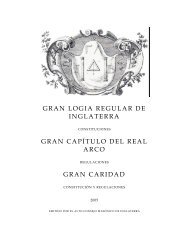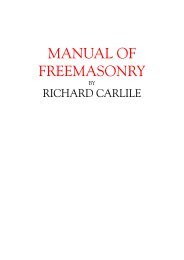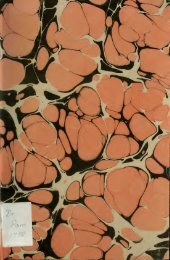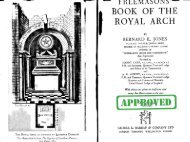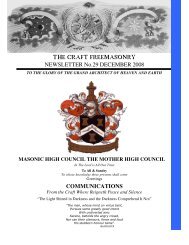THE CRAFT FREEMASONRY - Masonic High Council the Mother ...
THE CRAFT FREEMASONRY - Masonic High Council the Mother ...
THE CRAFT FREEMASONRY - Masonic High Council the Mother ...
You also want an ePaper? Increase the reach of your titles
YUMPU automatically turns print PDFs into web optimized ePapers that Google loves.
(1) ‘Court lawfully affirmed’ (i.e., <strong>the</strong> Lodge constituted and opened).<br />
(2) Roll-call. Absentees fined.<br />
(3) Admission of Entered Apprentices or Fellows of Craft.<br />
(4) Election of Officers (at <strong>the</strong> Annual Meetings).<br />
(5) Collection of fees, fines.<br />
(6) The Lodge in judgment (as a Court) against offenders.<br />
(7) Money-lending to members (upon security).<br />
This pattern of procedure repeats itself fairly regularly from <strong>the</strong> 1640s onwards. The routine,<br />
furnishings and equipment may have been very rough-and-ready, but it was from ancient Lodges like<br />
this one that <strong>the</strong> old traditions stemmed, and when <strong>the</strong>y began to acquire <strong>the</strong>ir special character, with<br />
richer symbolism and furnishings, <strong>the</strong>se were <strong>the</strong> Lodges that laid <strong>the</strong> pattern of `work’ which later<br />
spread all over <strong>the</strong> world.<br />
The Ritual of <strong>the</strong> Royal Arch<br />
Source, Bernard E. Jones’s book, “Freemasons Book of <strong>the</strong> Royal Arch”, in particular Section 14.<br />
“In <strong>the</strong> Beginning…”<br />
The earliest reference to a Royal Arch Ritual appears in a French manuscript currently held in <strong>the</strong><br />
library at Freemasons’ Hall. It is dated about 1760 and contains a collection of short synopses of <strong>the</strong><br />
thirty-five degrees in use at that period. The section concerning <strong>the</strong> Royal Arch refers to an<br />
underground room supported by nine arches with nine steps leading down to it and opened and closed<br />
by nine knocks. This scenario will be familiar to members of ano<strong>the</strong>r order. In a lecture on <strong>the</strong> tracing<br />
board which depicts <strong>the</strong> room, arches and steps, we are told of <strong>the</strong> nine brethren who were led by <strong>the</strong><br />
true light, <strong>the</strong> sun, to discover great secrets. Also depicted on <strong>the</strong> tracing board are a stone with a ring<br />
closing <strong>the</strong> chamber and a triangular plate of gold bearing <strong>the</strong> Sacred Name. The stone and ring<br />
suggest that <strong>the</strong> ritual was Irish in origin as that ritual, even today, has it as a feature. The ritual<br />
represents a date only 16 years after <strong>the</strong> first mention of <strong>the</strong> Royal Arch in 1744 and bears a close<br />
relationship to <strong>the</strong> ritual as it would be if <strong>the</strong> legend and lectures were removed.<br />
The next reference occurs in a ceremonial from 1766 wherein are found <strong>the</strong> two mottoes: “We have<br />
found” and “In <strong>the</strong> beginning was <strong>the</strong> Word”. The latter of <strong>the</strong>se will be revisited when dealing with <strong>the</strong><br />
late 18th century ritual and <strong>the</strong> 1835 revisions. For <strong>the</strong> moment it is only necessary to remark that, at<br />
that time, <strong>the</strong>se were <strong>the</strong> first words on <strong>the</strong> scroll found by <strong>the</strong> Sojourners.<br />
In 1769 shortly after <strong>the</strong> founding of <strong>the</strong> first Grand Chapter in 1766 <strong>the</strong>re is a minute from <strong>the</strong> Lodge<br />
of Unanimity, a ‘Moderns’ Lodge, meeting in Wakefield. The minute dated February 22nd 1769 relates<br />
to a special “night” when <strong>the</strong> Royal Arch was practised. These special nights which very often took<br />
place on a Sunday were a common custom in those days. After listing <strong>the</strong> names of <strong>the</strong> seven<br />
members present it lists thirteen “Toasts” or “Sentiments”. The following nine are those from <strong>the</strong> list<br />
which relate directly to <strong>the</strong> Royal Arch plus comments as to what <strong>the</strong>y may refer:<br />
- All tha’s gone thro’ t’seven<br />
31



